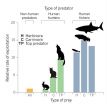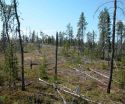(Press-News.org) Boston, MA -- A widely used class of industrial chemicals linked with cancer and interference with immune function--perfluorinated alkylate substances, or PFASs--appears to build up in infants by 20%-30% for each month they're breastfed, according to a new study co-authored by experts from Harvard T.H. Chan School of Public Health. It is the first study to show the extent to which PFASs are transferred to babies through breast milk, and to quantify their levels over time.
"We knew that small amounts of PFAS can occur in breast milk, but our serial blood analyses now show a buildup in the infants, the longer they are breastfed," said Philippe Grandjean, adjunct professor of environmental health at Harvard Chan School.
The study appeared online August 20, 2015 in Environmental Science & Technology. Other study authors were from Danish universities and the Faroese Hospital System.
PFASs are used to make products resistant to water, grease, and stains. They've been in use for more than 60 years in products such as stain-proof textiles, waterproof clothing, some food packaging, paints, and lubricants, and are known to contaminate drinking water in the U.S. near various production facilities. These compounds--which tend to bioaccumulate in food chains and can persist for a long time in the body--are found regularly in the blood of animals and humans worldwide, and have been linked with reproductive toxicity, endocrine disruption, and immune system dysfunction.
The researchers followed 81 children who were born in the Faroe Islands between 1997-2000, looking at levels of five types of PFASs in their blood at birth and ages 11 months, 18 months, and 5 years. They also looked at PFAS levels in mothers of the children at week 32 of pregnancy.
They found that, in children who were exclusively breastfed, PFAS concentrations in the blood increased by roughly 20%-30% each month, with lower increases among children who were partially breastfed. In some cases, by the end of breastfeeding, children's serum concentration levels of PFASs exceeded that of their mothers'.
One type of PFAS--perfluorohexanesulfonate--did not increase with breastfeeding. After breastfeeding was stopped, concentrations of all of five types of PFASs decreased.
The results suggest that breast milk is a major source of PFAS exposure during infancy.
"There is no reason to discourage breastfeeding, but we are concerned that these pollutants are transferred to the next generation at a very vulnerable age. Unfortunately, the current U.S. legislation does not require any testing of chemical substances like PFASs for their transfer to babies and any related adverse effects," Grandjean said.
INFORMATION:
Funding for the study came from the National Institute of Environmental Health Sciences, NIH (ES012199); the U.S. Environmental Protection Agency (R830758); the Danish Council for Strategic Research (09-063094); and the Danish Environmental Protection Agency as part of the environmental support program DANCEA (Danish Cooperation for Environment in the Arctic).
"Breastfeeding as an Exposure Pathway for Perfluorinated Alkylates," Ulla B. Mogensen, Philippe Grandjean, Flemming Nielsen, Pal Weihe, and Esben Budtz-Jørgensen, Environmental Science & Technology, August 20, 2015, doi: 10.1021/acs.est.5b02237
Visit the Harvard Chan School website for the latest news, press releases, and multimedia offerings.
Harvard T.H. Chan School of Public Health brings together dedicated experts from many disciplines to educate new generations of global health leaders and produce powerful ideas that improve the lives and health of people everywhere. As a community of leading scientists, educators, and students, we work together to take innovative ideas from the laboratory to people's lives--not only making scientific breakthroughs, but also working to change individual behaviors, public policies, and health care practices. Each year, more than 400 faculty members at Harvard Chan teach 1,000-plus full-time students from around the world and train thousands more through online and executive education courses. Founded in 1913 as the Harvard-MIT School of Health Officers, the School is recognized as America's oldest professional training program in public health.
In-depth interviews conducted by researchers at the Johns Hopkins University School of Medicine of 20 young women attending an urban sexually transmitted disease clinic have documented a variety of unexpected, unintended sexual encounters linked to their alcohol use before sex occurs.
Links between alcohol use and risky or deleterious sexual encounters are not necessarily new, say investigators, but this small study identifies very specifically the disconnect between what young women have in mind when they drink and have sex and what really happens.
"The idea behind ...
According to a survey conducted by Rhode Island Hospital researchers, there is significant variability regarding how clinicians manage catheters placed in the arteries of patients in intensive care units. Some practices may increase risk of infection associated with these catheters. Fewer than half of those surveyed complied with current Centers for Disease Control and Prevention (CDC) infection prevention guidelines for arterial catheter insertions. The study was published today in Critical Care Medicine.
"Barrier precautions are employed inconsistently by critical care ...
Washington, DC - August 20, 2015 - Swedish exchange students who studied in India and in central Africa returned from their sojourns with an increased diversity of antibiotic resistance genes in their gut microbiomes. The research is published 10 August in Antimicrobial Agents and Chemotherapy, a journal of the American Society for Microbiology.
In the study, the investigators found a 2.6-fold increase in genes encoding resistance to sulfonamide, a 7.7-fold increase in trimethoprim resistance genes, and a 2.6-fold increase in resistance to beta-lactams, all of this without ...
PHOENIX, Ariz. -- Aug. 20, 2015 -- A study by the Translational Genomics Research Institute (TGen) and other major research institutes, found a new set of genes that can indicate improved survival after surgery for patients with pancreatic cancer. The study also showed that detection of circulating tumor DNA in the blood could provide an early indication of tumor recurrence.
In conjunction with the Stand Up To Cancer (SU2C) Pancreatic Cancer Dream Team, the study was published in the prestigious scientific journal Nature Communications.
Using whole-exome sequencing ...
If dark energy is hiding in our midst in the form of hypothetical particles called "chameleons," Holger Müller and his team at the University of California, Berkeley, plan to flush them out.
The results of an experiment reported in this week's issue of Science narrows the search for chameleons a thousand times compared to previous tests, and Müller, an assistant professor of physics, hopes that his next experiment will either expose chameleons or similar ultralight particles as the real dark energy, or prove they were a will-o'-the-wisp after all.
Dark energy ...
Management of boreal forests needs greater attention from international policy, argued forestry experts from the International Institute for Applied Systems Analysis (IIASA), Natural Resources Canada, and the University of Helsinki in Finland in a new article published this week in the journal Science. The article, which reviews recent research in the field, is part of a special issue on forests released in advance of the World Forestry Congress in September.
"Boreal forests have the potential to hit a tipping point this century," says IIASA Ecosystems Services and Management ...
This news release is available in Japanese.
Humans are just one of many predators in this world, but a new study highlights how their intense tendency to target and kill adult prey, as well as other carnivores, sets them distinctly apart from other predators. As humans kill other species in their reproductive prime, there can be profound implications -- including widespread extinction and restructuring of food webs and ecosystems--in both terrestrial and marine systems. To evaluate the nature of human predation compared to nonhuman predation, Chris Darimont et al. conducted ...
This news release is available in Japanese.
In this special issue, the editors of Science invite experts to provide closer looks at how natural and human-induced environmental changes are affecting forests around the world, from the luscious, diverse forests of the tropics, to the pristine, resilient boreal forests of the north. The special issue is complemented by a package from Science's news department.
Amid extreme environmental and climate changes, Susan Trumbore and colleagues highlight the urgency of monitoring forest health, especially ...
This news release is available in Japanese.
Amid continued difficulties around assessing bioweapons threats, especially given limited empirical data, Crystal Boddie and colleagues took another route to gauge their danger: the collective judgment of multiple experts. The experts' opinions on bioweapons-related risks were quite diverse, the Policy Forum authors say, adding to the challenge around developing a regulatory system for legitimate dual use research. Boddie et al. explain how they employed a Delphi Method study to query the beliefs and opinions of 59 experts ...
An examination of the immune genes of the southern African Khoe-San people has revealed a completely new kind of mutation, according to researchers at the Stanford University School of Medicine. The gene variant likely contributes to healthier babies, although the variant can also lower resistance to disease.
The findings grew out of a long-term effort by Peter Parham, PhD, professor of structural biology and of microbiology and immunology, to understand how immune system genes make us reject organ transplants.
A paper detailing the findings will be published online ...


